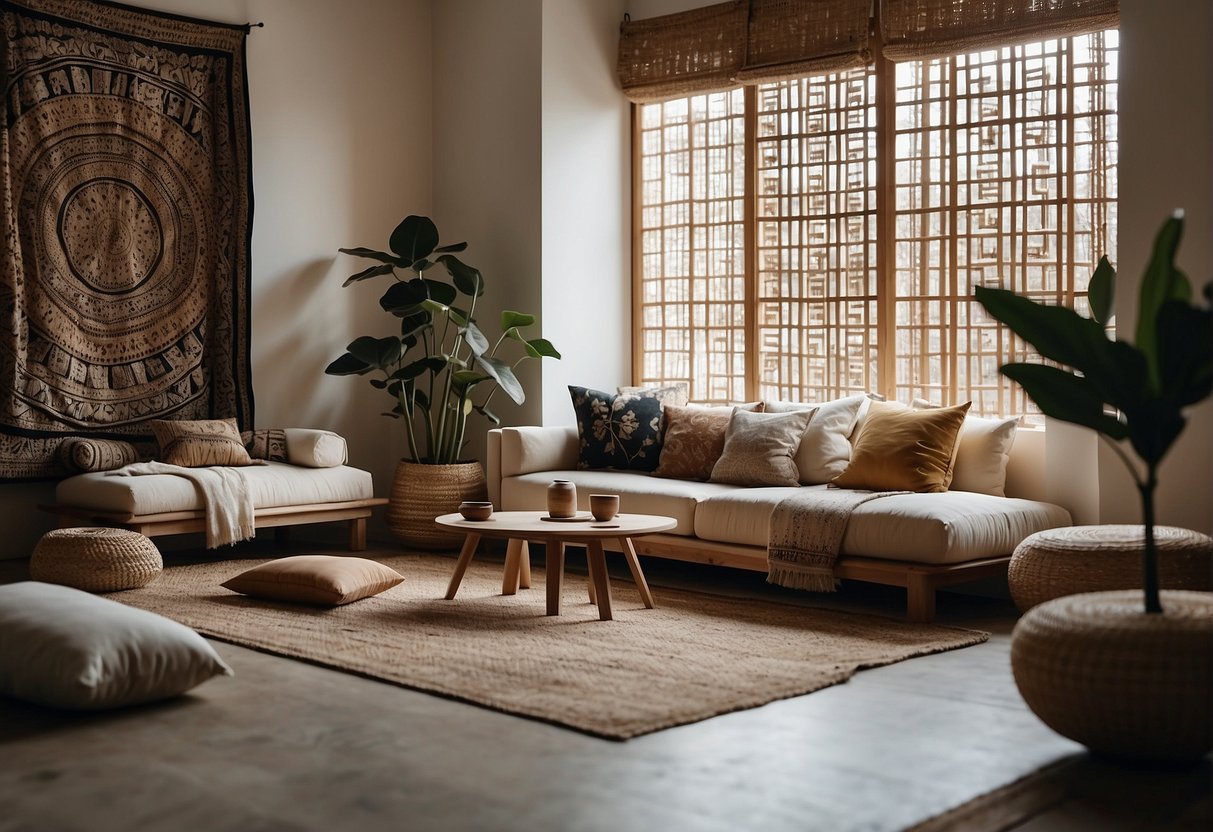Blending Traditions in Modern Spaces
Interior design has long been a canvas for cultural expression, where aesthetics from various parts of the world converge and interact. Contemporary interior design, with its emphasis on minimalism and functionality, continues to evolve by integrating diverse cultural influences. This blending creates spaces that not only resonate with modern sensibilities but also pay homage to the rich tapestry of global traditions.

As travel and technology bring us closer together, interior designers and homeowners alike are seeking ways to infuse their spaces with cultural elements that tell stories and add depth. Whether it’s through the incorporation of traditional patterns, color schemes, or furnishings, these cultural accents offer a way to celebrate diversity and bring a unique, cosmopolitan feel to modern homes.
At the core, the integration of cultural aesthetics into contemporary design reflects a growing appreciation for the world’s variety within the context of interior design. It’s more than a trend; it’s a nod to the beautiful complexities of our global community and a shared desire for interiors that are not just stylish, but also culturally inclusive and aware.
The Essence of Culture in Modern Spaces

When walking into a contemporary space, one can often sense the world’s cultures converging. Today’s interior design frequently mirrors an array of traditions and cultural influences, creating diverse and united environments.
Identifying Cultural Influence in Contemporary Design
Incorporating cultural elements into a space begins with identifying the cultural influence that resonates with the design intent. For example, an area might feature Chinese aesthetics, reflecting Confucian principles of harmony, with spaces designed to promote tranquility and balance. This approach not only infuses the design with deep-seated cultural heritage but also maintains a connection to age-old philosophies in a modern setting.
Cultural Diversity and Representation in Design
Modern interior design aims for more than just aesthetics; it’s about creating spaces that represent cultural diversity and provide a sense of belonging. Designers often weave a tapestry of diverse cultural influences, being mindful of representation across various ethnicities. They may blend Scandinavian minimalism with bold African patterns or harmonize Japanese simplicity with vibrant Indian textiles. This cultural fusion brings together different traditions to craft interior landscapes that speak to a universally human experience while still honoring the distinctness of each culture.
Incorporating Traditional Elements into Modern Interiors

Merging timeless appeal with contemporary style, incorporating traditional elements into modern interiors can create a unique and culturally rich space. It’s about finding the perfect balance between the sleek, clean lines of modern design and the ornate, meaningful characteristics of traditional aesthetics.
Balancing Modern and Traditional Aesthetics
To achieve harmony between modern and traditional styles, one might blend clean lines with ornate patterns. For instance, a minimalist modern sofa can be paired with accent pillows featuring traditional motifs. This juxtaposition creates a focal point that respects cultural influences while maintaining a fresh, modern feel.
Textiles and Textures: Weaving Culture into Design
Traditional textiles bring warmth and cultural narratives to contemporary spaces. Silk or hand-woven cotton fabrics can introduce texture and pattern, subtly weaving in traditional elements that complement modern simplicity. These fabrics can serve as drapery, upholstery, or even as wall hangings to add visual interest and depth.
Wood and Stone: Natural Materials with Cultural Significance
Incorporating natural materials such as wood and stone can ground a modern interior with elements that have a strong cultural resonance. A sleek wooden table, crafted with techniques passed down through generations, or a stone fireplace reminiscent of a certain region’s architectural heritage, can serve as a bridge between nature and modernity.
Artifacts and Artworks: Adding Personal and Cultural Narratives
Strategically placed artifacts and artworks can tell a story within a space. Whether it’s a piece of Art Deco sculpture or a traditionally crafted pottery vase, these objects add layers of personal and cultural narratives. They break up the monotony of modern design with their distinct textures and historical context.
Global Cultural Aesthetics and Interior Design

Modern interior design often entails blending diverse cultural elements to create spaces that reflect a rich tapestry of global heritage. These incorporations range from the vibrant color palettes of Asia to the indigenous patterns of South America, all of which contribute to eclectic interiors rich in cultural influence.
From Asia to South America: Diverse Inspirations
Asian interior design aesthetics are marked by a tranquil sensibility, rooted deeply in cultural heritage. Japanese design, for instance, is characterized by minimalism, natural elements, and a serene color palette, embodying simplicity and functionality. The influence of countries like China and India is evident through the use of intricate patterns, bold colors, and ornate decor reflecting their historical art and architectural practices. Traditional elements are often juxtaposed with modern ones to create a harmonious eclectic space that’s both inviting and bold.
Moving across the globe, South American interiors are infused with a vibrant energy that reflects the region’s cultural diversity. Designers might weave in rich textures and earthy tones inspired by indigenous art, or they might channel the electric atmosphere of a Rio carnival through vivacious patterns and hues. This melting pot of indigenous and European influences makes for a uniquely energetic aesthetic — think bright ceramics or hand-woven textiles that echo the cultural narrative of their origin.
Influence of Art Movements and Regional Architecture
The Art Deco movement, with its origins in early 20th-century France, permeates modern interior design with its bold geometric patterns, rich colors, and luxurious materials. With the resurgence of this style, designers interweave its opulent character and symmetry into contemporary spaces, giving them a touch of glamour that alludes to the cultural opulence of the ’20s and ’30s.
Regional architecture heavily informs interior aesthetics as well. For instance, the clean lines and functional beauty inherent in Scandinavian design mirror the architectural philosophy of simplicity and lightness from the Nordic countries. The laid-back yet sophisticated approach harnesses natural light, neutral colors, and an affinity for wood, bringing forth an atmosphere that’s unmistakably tranquil and warm.
In blending these diverse cultural influences and architectural styles, designers create eclectic environments that celebrate the rich tapestry of global culture, giving individuals the opportunity to connect with different cultures through their everyday surroundings.
Design Elements for Multicultural Appeal

Incorporating design elements that reflect a broad range of cultural influences can create interiors with a universal appeal. This requires a thoughtful blend of color, pattern, and furnishings that tell cultural stories and add visual interest.
Colour and Pattern: Communicating Culture Visually
Colour and pattern are indispensable when they represent the visual language of culture in interior design. A room that harnesses a palette with warmth may borrow deep reds from traditional Moroccan themes or vibrant blues reminiscent of Greek coastal villages. Geometric patterns can echo the meticulous details found in Islamic art, while lush, lively prints may pull inspirations from the tropics. Together, such elements infuse a sense of cultural richness into a space.
Furniture and Furnishings Reflecting Cultural Stories
Furniture and furnishings are the narrative components of design that bring cultural stories into a home. One may find eclectic furnishings that mix the sleek lines of Scandinavian design with the ornate details of Indian craftsmanship. Furniture design focused on texture might include plush textiles, carved woods, or woven natural fibers, each sourced from different corners of the world to promote a cohesive yet captivating environment.
Practical Considerations in Culturally-Influenced Design
When incorporating cultural elements into interior design, it’s not just about aesthetics—the practicality of design choices and the responsibility of sourcing come to the forefront. Designers look at functionality, comfort, and the sustainable acquisition of materials.
Functionality and Comfort in Design Choices
Functionality remains a cornerstone in interior design, even when integrating cultural aesthetics. Cultural motifs can enrich a space, yet they should serve a purpose beyond decoration. Japanese minimalism is a testament to this principle, emphasizing not just the beauty of clean lines and simplicity but also the practical benefits of living in uncluttered spaces. Designs should consider everyday use, ensuring that traditional motifs or culturally specific materials enhance the user’s experience. Comfort is paramount, which means designers often opt for natural materials that offer both durability and a tactile sense of ease.
Sustainability and Ethical Sourcing in Design
As the design industry pivots towards sustainability and ethical practices, the sourcing of materials and the inclusion of traditional patterns or techniques require careful consideration. Designers might incorporate bamboo or recycled fabrics, linking aesthetics with environmental consciousness. Ethical sourcing also involves supporting local artisans and ensuring fair economic practices within the supply chain. A consultation with cultural experts can help identify sources that align with these values. This approach not only respects the origin of materials and motifs but also promotes an international design narrative that’s responsible and authentic.
Conclusion
Incorporating cultural influences into contemporary interior design isn’t just about aesthetics; it’s about honoring diversity and creating spaces that resonate on a deeper level. Designers often intertwine elements from various cultures, weaving a tapestry of styles that reflect a more interconnected world. The result? Rooms that don’t just look good but also tell a story—one of heritage, artistry, and shared human experience.
The beauty of this approach lies in its ability to foster a sense of unity. No matter where someone comes from, they can find a piece of themselves within the design. It’s this inclusive nature that makes a culturally-infused interior design so appealing. Through thoughtful representation, interiors become a mirror for the myriad of lifestyles and traditions around the globe.
Ultimately, embracing cultural diversity in design isn’t merely a trend. It’s a bold move towards a more empathetic and beautifully eclectic way of living. With every choice of fabric, furniture, and fixture, designers have the chance to celebrate cultural diversity and craft a visual language that speaks to the heart of global citizenship.





